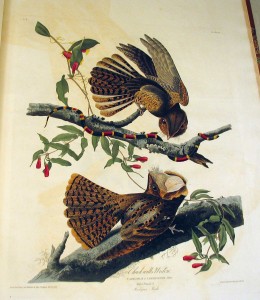 “Our Goatsuckers, although possessed of great power of wing, are particularly attached to certain districts and localities. The species now under consideration is seldom observed beyond the limits of the Choctaw Nation in the State of Mississippi, or the Carolinas, on the shores of the Atlantic, and may with propriety be looked upon as the southern species of the United States. Louisiana, Florida, the lower portions of Alabama and Georgia, are the parts in which it most abounds; and there it makes its appearance early in spring, coming over from Mexico, and probably still warmer climates.
“Our Goatsuckers, although possessed of great power of wing, are particularly attached to certain districts and localities. The species now under consideration is seldom observed beyond the limits of the Choctaw Nation in the State of Mississippi, or the Carolinas, on the shores of the Atlantic, and may with propriety be looked upon as the southern species of the United States. Louisiana, Florida, the lower portions of Alabama and Georgia, are the parts in which it most abounds; and there it makes its appearance early in spring, coming over from Mexico, and probably still warmer climates.
About the middle of March, the forests of Louisiana are heard to echo with the well-known notes of this interesting bird. No sooner has the sun disappeared, and the nocturnal insects emerge from their burrows, than the sounds, “chuck-will’s-widow,” repeated with great clearness and power six or seven times in as many seconds, strike the ear of every individual, bringing to the mind a pleasure mingled with a certain degree of melancholy, which I have often found very soothing. The sounds of the Goatsucker, at all events, forebode a peaceful and calm night, and I have more than once thought, are conducive to lull the listener to repose.
. . .The Chuck-will’s-widow manifests a strong antipathy towards all snakes, however harmless they may be. Although these birds cannot in any way injure the snakes, they alight near them on all occasions, and try to frighten them away, by opening their prodigious mouth, and emitting a strong hissing murmur. It was after witnessing one of these occurrences, which took place at early twilight, that the idea of representing these birds in such an occupation struck me. The beautiful little snake, gliding along the dead branch, between two Chuck-will’s widows, a male and a female, is commonly called the Harlequin Snake, and is, I believe, quite harmless.”
–J. J. Audubon, Ornithological Biography, I (1831), 273-276 [excerpted].